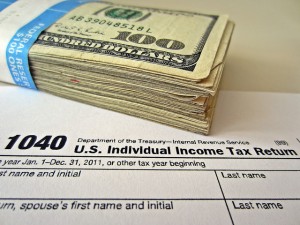Health Insurance Tax Penalty and what you need to know about them
Apr 25th, 2014
With tax season just having passed you may have been wondering while filling out your forms, how the the Affordable Care Act, AKA Obamacare, will be affecting your tax situation, as it relates to the health insurance tax penalty. There is a lot of misinformation out there when it comes to the ACA, especially about its various health insurance tax penalties for not having health insurance. So let’s take a deeper look.
Paying the health insurance tax penalty for the Individual Mandate
As many of you probably know at the very least the ACA requires every United States citizen and legal residents carry some sort of health insurance policy that either meets, or exceeds the minimum coverage standards of the ACA.
You can also continue to keep your old health insurance plan that doesn’t quite meet the new standards of the ACA if you’re grandfathering it in. As an aside, grandfathering in your old health insurance plan means that the policy was in existence before the ACA became law and it still meets certain relaxed affordability and coverage requirements.
Anyway, so the letter of the law that is the ACA mandates you have a health insurance plan for all of 2014 or pay a penalty when you file your 2014 taxes.
Some Americans, for reasons political or otherwise, have opted to not purchase health insurance for 2014. These folks when they file their 2014 taxes in April 2015 will pay a penalty of $95 per adult and $47.50 per child (up to $285 for a family) or 1% of their taxable income, whichever is greater.
Doesn’t sound too bad right? Well $95 is only the start. In 2015 the health insurance tax penalty amount goes up. Here’s how it breaks down for the next few years:
2014 = $95 per person per year or 1% of your Income
2015 = $325 per person per year or 2% of your Income
2016 = $695 per person per year or 2.5% of your Income
Starting in 2017 the individual health insurance tax penalty will still continue to increase, but it will be pegged to the rate of inflation. Children are always assessed the individual mandate penalty at 50 percent of the adult rate.
A few things about the penalty
For the most part the individual tax penalty is pretty straight forward. If you don’t have health insurance, you pay the fee. However if you’re only uninsured for part of the year, one twelfth of the penalty applies to you for each month of the year you’re uninsured. Also if you’re uninsured for less than three months then you don’t have to worry about paying the penalty so long as you’re able to re-enroll before the end of three months. That can be a little tricky though outside of the open enrollment period. That is unless you qualify for a special enrollment period.
There is also a cap on the maximum amount you can be changed for the penalty. The total penalty for the taxable year cannot exceed the national average of the annual premiums of a bronze-level health insurance plan offered through the New York State Health Insurance Exchange.
You might also be wondering how the federal government will know that you are insured. There is actually no extra paperwork that you need to fill out on your end. The health insurance company will inform the government and IRS that you’re insured.
A different kind of penalty
There is one different kind of health insurance penalty you can get hit with that you might not know about, but could be equally destructive to your finances if you’re not ready for it.
As you probably know, one of the big appeals of health insurance plans sold at the New York State Health Insurance Exchange is that depending on your income level you could be eligible to receive a fairly substantial federal health insurance subsidy to make your insurance more affordable. Specifically if your income is between 138 and 400 percent of the current years Federal Poverty Level you get a subsidy. The less you make, the bigger your subsidy.
The subsidy is a very powerful thing and really does make health insurance exchange plans a lot more affordable for certain groups of New Yorkers. Check your subsidy eligibility here. When you’re applying for health insurance the New York State Health Insurance Exchange determines your eligibility for a subsidy and offers you the full amount that you qualify for.
Now as part of the application process at the New York State Health Insurance Exchange you’re asked to project your income for the following year. It’s that projected income number that your subsidy amount is based off of. So if you guess wrong, or you have an unexpected income change during the next year that will impact your subsidy.
Nothing will change right away for you if for example your income increase so much that you would no longer be eligible for a health insurance subsidy. But during the following year’s tax season you’re expected to pay back whatever extra amount you took in the form of health insurance subsidies that you weren’t eligible for after your income change.
Depending on your situation this can be a huge amount of money. As a way to prevent this from happening, we recommend that you only accept part of the subsidy offered to you at the New York State Health Insurance Exchange. Even if you have no income change during the year, and you only took a partial subsidy to be on the safe side, you can get back whatever other amount you didn’t take up front, during the following year’s tax season.
Related posts from our blog:
No related posts.
Tags: aca | affordable care act | individual mandate | obamacare | tax penalty
Posted in: Simon Bukai | Comments Off
